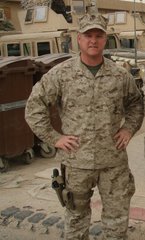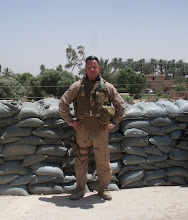I have another guest blog entry from Colonel Michael Visconage at Camp Victory in Baghdad. For those new to my blog the Colonel is my Commanding Officer and is the Officer in Charge of my unit “USMC Field History” in Quantico VA. He is on a six month deployment to the Joint Historical Office in Baghdad. For clarification I am at a smaller base west of Baghdad (Forward Operating Base, Fallujah) and as a historian cover activity in the western “Al Anbar” province of Iraq, The Colonel is at Higher Headquarters. Enjoy his view of life at Camp Victory.
The Camp Victory Life:
The Victory base camp is on the Southwest outskirts of Baghdad is part of a much larger expanse that has a number of other sub camps for the combat divisions and a variety of support troops. My guess would be that is covers perhaps 20 square miles and houses 40-50,000 people. While the staff has the easy life in terms of a low level of immediate danger, the fighting troops are usually out in the various forward operating bases and have much harsher living condition. They do get to rotate back to larger bases for periods of time, which I am sure they appreciate.
In many ways, life for those on the large support bases is a totally different and safe existence. If I were a civilian specialist in some capacity and was offered a bucket of money to work at Camp Victory for six months or a year, I’d take it in minute. The “risk to reward” ratio is minimal. The only hardship is separation from family and minor inconvenience of the living environment. Most of the staff and contractors will never leave their base camps. The soldiers, sailors, airmen, and Marines who are combat and combat support units are the ones who go “outside the wire” and risk their lives on a daily basis. Most of the casualties are from improvised explosive devises of one type or another—an enemy you will never see or have a chance to return fire at.
The Al Faw Palace where I work is part of Camp Victory. It’s actually a complex of buildings that Saddam Hussein built around a group of small man-made lakes—villas for his henchmen and any number of support buildings. He also had a private zoo and a hunting preserve here. Many of the buildings were damaged to some degree during the initial attack, but have been repaired for service as offices or living quarters for our general officers. Even still, most windows are sand-bagged as protection against attacks and many sensitive areas are protected by sentry posts and concertina (barbed) wire. At night most lights are out and it’s dark, although not a total “blackout” environment that you might picture from a traditional war setting.
While the palaces feature lots of marble on the inside and are architecturally interesting from the outside, the surrounding areas are typically dry and dusty. Imagine a million dollar home plunked down in the middle of a trailer park and you get the general picture. A layer of fine sand/dirt covers virtually everything outside, and quit a lot of things inside if left unattended. Much of the open space in the area surrounding the working spaces has been taken up with temporary trailers, tents and buildings for living, working, eating, exercise, and so on.
Since this is the focal point for the command element, the immediate area of the Al Faw Palace is something like a college campus with 90% of the people armed and in some kind of uniform. The other 10% are civilian contractors who are either skilled American workers (IT, intelligence analysts, contractors, etc.) or low-skill end third-country national from India, Pakistan and the Philippines who run the dining facility, laundry and general maintenance. Since we operate 24-hours-a-day, so does the base. Starting with the operations center, about half the staff sections work in shifts to cover issues that come up day or night. Smaller sections like mine, or those with predictable missions, cover the primary working hours of the staff and generals—usually about 7 in morning until 9 or 10 at night.
The food is reasonably good and KBR, the contractor who runs the dining facility, does a good job of trying to provide a reasonable variety. Again, a lot like a college dining facility. When you get a break (or need a break) the gym is popular and has good selection of free weights and exercise machines. Given the military focus on fitness, this is something that is good for morale and also gives people a positive outlet. There’s also both a small 24-hour PX and somewhat larger PX for basic supplies. Still not home, but you can get most of the essentials you would need--just not in the size, color, or type you’re looking for. The advice passed on to me for PX shopping was, “If you see something you need be sure to buy it today, because it won’t be there tomorrow.”
I’m lucky because I rate a “wet” trailer for my living accommodations. This means I live in something like a basic single-wide trailer that is divided in the middle and has a shared bathroom between the two residents. The trailers are placed end-to-end, row upon row with concrete blast walls between each row as protection against mortar or rocket attacks. Those below the rank of colonel usually share a “dry” trailer—meaning they have to bunk in with others and also have to go outside to a separate trailer with toilets and showers. Since I spend so little time in my room, I am content with the bed and wall locker that are provided. Some of the more junior service members who work on set shifts will try to make their trailer a bit more like home with T.V., DVD player, Play Station, rugs, etc. There is access to the military Armed Forces Network television system and there are a few satellite dishes lashed to trailer roofs in a temporary fashion. One more industrious occupant had an old ironing board turned upside down on their roof as an antenna (the college analogy continues).
Some industrious contractors who live a few rows down from me have actually turned their aisle between the trailers and the blast wall into a café of sorts (about 8’ wide). They’ve built some restaurant-style booths to accommodate about 12-14 people and got their hands on some outdoor umbrellas, posters, flags, a grill, and some Christmas lights to give it atmosphere. There’s no alcohol allowed here, but they keep some beverages on hand as someone has a fridge in their trailer and cook out when they can get their hands on some hamburger or ribs. They call it Baba’s Café and run it as a “by invitation” establishment and have a gathering 2-3 times a week. As one of the regulars said, “We have to keep it quiet. You know how it is, as soon as some senior officer figures out we’re having fun they’ll make us take it all down.”
I did have to convince them that I wasn’t that senior officer in order to get them to tell me how they got they got started. Baba’s Café gets something of an international crowd (by crowd, I mean 15-20 people max) that sometimes includes interpreters, coalition military reps, Iraqi Army officers, all U.S. military services, contractors, and so on. For those here for a year or more in particular, it helps to make it a little like home away from home. Baba’s is just a little piece of cultural history of camp life for the archives.
Tuesday, July 24, 2007
Subscribe to:
Post Comments (Atom)


1 comment:
Colonel, thanks for the excellent graphic descriptions. Baba's Cafe sounds a right noble place to receive an invite to.
Somehow, we continue to remain stunned that word pictures like this remain completely uninteresting to stateside newspaper editors. How they have come to the idea that such reporting of the basics of life in Iraq is not interesting to the loved ones, friends, neighbors, co-workers, of those who serve, still just baffles me.
I dunno. Maybe we should have a program where the local recruiters in small towns in Ohio and Oklahoma submit articles like yours to the under-30,000 circulation home-town papers. Maybe we should give you a camera for the MNF-Iraq channel on Youtube.
Thanks again for the descriptions.
Post a Comment